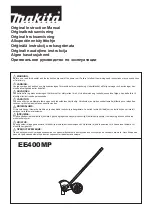
Operation: Clear-cut Harvesting
AM24480,0000064 -19-05JUL19-1/1
DS17474,000004C -19-05JUL19-1/1
AM24480,0000066 -19-05JUL19-1/1
Felling
The felling stage in clear-fell influences the whole
operation.
The felling direction and stem presentation for extraction
requires careful attention, in order to reduce breakage
and to be able to present a well-delimbed stem for quick
extraction or further processing.
To reduce breakage, and provide a larger working radius,
it is preferable to fell trees against standing trees to
cushion the fall and reduce the amount of undergrowth
around the base of trees to be felled. This is achieved by
felling the tree just off-center to a standing tree, preventing
the falling tree becoming hung up.
It is preferred an operator has manual felling experience,
allowing a better understanding of felling techniques.
Felling Process
The direction of the fall is determined by the position of
the harvester head; the tree should fall in a direct line with
the tilt frame.
Position the harvester head on the tree as low as possible
while gaining the correct felling angle. Consequently, the
delimb arms and feed roller arms should be fully opened
and the harvester head in the tilt up position. Close the
delimb arms and feed roller arms once the selected tree is
positioned in the opening.
A slight amount of pressure is then applied to the tree to
ensure the saw chain will not jam as the tree is being cut.
When the saw chain is activated, both delimb and feed
arms circuits will operate at their highest setting to ensure
the tree does not move within the harvester head while
cutting is taking place. A stream of chips leaving the saw
chain box area provides a visual indication of the cutting
taking place. Keep the saw chain activated until the tree
can be felt to move vertically. Stop the saw chain, which
automatically retracts, and apply force to the tree in the
direction of the fall.
At full reach of harvester head, tree control gets reduced.
Optimum felling is achieved using the harvester head as
close as possible to 3/4 of maximum reach. During these
manoeuvres, the base unit should remain firm at all times.
A reduction in reach will need to be immediately applied if
the base unit becomes unstable. Ensure the tracks are
on a firm footing at all times, avoiding locating one or both
tracks on stumps which could allow the carrier to move
unexpectedly during manoeuvres.
XJ1
127323
—UN—04DEC12
Higher production is achieved through maximum ground
coverage with minimal track movement. This also reduces
environmental impact.
Delimbing
At this point, the tree is ready to be delimbed. This
involves rotating the base and feeding the stem through
the harvester head, while obtaining the correct direction of
the butt. Once the butt has been positioned, the remainder
of the tree can be delimbed, using the momentum of the
harvester head to assist the delimbing effort.
Care must be exercised when swinging stems around,
so as not to allow contact with the operator’s structure,
and to be aware of tail swing which could damage other
trees or stems.
•
Ensure the delimb arms are kept sharp, and in form, to
reduce the effort required to remove limbs.
•
The delimbing procedure is about balance and stem
control, which, when perfected, gives excellent results
and increases production.
•
Do not feed the stem through the harvester head while
the stem is facing the operator’s structure.
It is recommended that during delimbing the harvester
head is only just high enough to position the butt and clear
objects. Operating the harvester head too high will result
in loss of control of the stem and/or stem breakage.
2-2-1
090721
PN=32
Содержание HTH618C
Страница 2: ......
Страница 91: ...Index Index 3 090721 PN 91 ...
Страница 92: ...Index Index 4 090721 PN 92 ...
















































